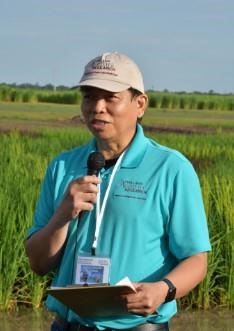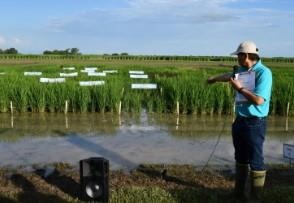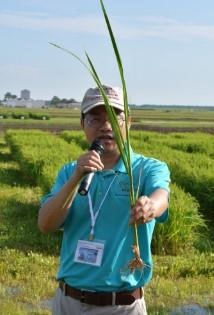With a growing demand for aromatic rice in the U.S., Texas A&M AgriLife Research scientists are stepping up field trial experiments and breeding activities to develop basmati and jasmine rice varieties that would best fit the state’s production environment and help meet growing consumer demand.
 Stanley Omar Samonte, Ph.D., Texas A&M AgriLife Research rice breeder, discusses his breeding trials. (Texas A&M AgriLife Marketing and Communications photo by Blair Fannin)
Stanley Omar Samonte, Ph.D., Texas A&M AgriLife Research rice breeder, discusses his breeding trials. (Texas A&M AgriLife Marketing and Communications photo by Blair Fannin)The latest work was showcased recently at the 74th annual Beaumont Field Day themed Designing Texas Rice for the Future at the Texas A&M AgriLife Research and Extension Center at Beaumont. The annual event gives the region’s rice growers a first-hand look at innovations to consider for their operations.
“The main focus of what we do is rice cropping systems and what we are trying to do is go beyond classical long grain types,” said Ted Wilson, Ph.D., center director and holder of the Jack B. Wendt Endowed Chair in Rice Research. “Historically, a minimum of 98% of the rice grown in Texas is long grain rice with a little jasmine and aromatic types. Right now, the imports of rice from other countries are steadily increasing.”
Wilson said that in 2020 the U.S. imported $1.3 billion of rice from other countries and sold $1.9 billion.
“Rice imports are increasing at a slow, steady rate,” Wilson said. “The question is where is our money going? The imports are basmati types from India and Pakistan and jasmine is coming from Thailand, Vietnam and Cambodia. Those two varieties make up most of the rice imported, while only 1.7% of Texas acreage in 2021 was grown in basmati rice.”
Breeding for Texas rice
Stanley Omar Samonte, Ph.D., AgriLife Research rice breeder in the Texas A&M Department of Soil and Crop Sciences, Beaumont, told attendees that work continues looking into breeding new jasmine and basmati lines to fit Texas’ growing environment and meet consumer demand to compete with imports. From 2010 to 2020, the US imported an average of 685,000 tons per year. U.S.-grown aromatic rice, which includes the jasmine and basmati varieties, makes up less than 1% of the market share.
 Stanley Omar Samonte, Ph.D., Texas A&M AgriLife Research rice breeder, discusses plant breeding work at the 74th annual Beaumont Field Day. (Texas A&M AgriLife photo by Blair Fannin)
Stanley Omar Samonte, Ph.D., Texas A&M AgriLife Research rice breeder, discusses plant breeding work at the 74th annual Beaumont Field Day. (Texas A&M AgriLife photo by Blair Fannin)“To meet the increasing demand, we are having to breed for basmati and jasmine lines that are adaptable to Texas conditions,” Samonte said.
Some of the challenges for breeding basmati varieties is 60% of the varieties are unacceptably tall and cannot be grown along the Gulf Coast due to lodging. They are also low yielding with no secondary or ratoon crop.
Samonte said there is “tremendous opportunity for U.S. rice breeders” to develop Texas jasmine and basmati type varieties that feature the same aroma, flavor, and texture preferred by U.S. consumers. His current project includes F2 second generation plant populations in breeding nurseries that are being screened to develop aromatic jasmine and basmati rice types.
Samonte’s specialty rice breeding project for jasmine, basmati, and high amylose rice types is funded by the Texas Rice Research Foundation.
Breeding concentrates on important traits
 Xin-Gen “Shane” Zhou, Texas A&M AgriLife Research rice plant pathology/weed management, discusses new rice diseases in Texas. (Texas A&M AgriLife photo by Blair Fannin)
Xin-Gen “Shane” Zhou, Texas A&M AgriLife Research rice plant pathology/weed management, discusses new rice diseases in Texas. (Texas A&M AgriLife photo by Blair Fannin)Wilson also noted the research program includes rice varieties bred for high amylose concentrations, which have healthful benefits for those with diabetes, obesity or colon diseases.
He said the AgriLife Research scientists at Beaumont Center are investigating kernel smut, narrow brown leaf spot, and brown spot diseases.
“Kernal smut has gone from obscure to horrendous,” Wilson said. “2021 was horrendous. We had one of our producers that lost 300 acres or had 18% infected kernels. Maybe all of our growers need to learn that with kernel smut, they have to be really careful with nitrogen applications. It thrives on a high nitrogen application near panicle differentiation. It will get you in hot water quickly.”
Focus on controlling stink bug infestations is another area of work. Lina Bernaola, Ph.D., recently joined AgriLife Research at Beaumont specializing in integrated pest management and host plant resistance. She is taking over for longtime researcher and nationally recognized Mo Way, who retired last year after nearly 50 years dedicated to rice research, 39 of those years with AgriLife Research.
 Ted Wilson, Ph.D., Texas A&M AgriLife Research Center at Beaumont director, and Brenda Tubena, Ph.D., Louisiana State University AgCenter, at the 74th annual Beaumont Field Day. (Texas A&M AgriLife photo by Blair Fannin)
Ted Wilson, Ph.D., Texas A&M AgriLife Research Center at Beaumont director, and Brenda Tubena, Ph.D., Louisiana State University AgCenter, at the 74th annual Beaumont Field Day. (Texas A&M AgriLife photo by Blair Fannin)Attendees also heard updates from Marcela Garcia, president and CEO, U.S. Rice Producers Association. Brenda Tubena, Ph.D., Louisiana State University AgCenter, discussed remote sensing applications for precise nitrogen. Morning tours led by AgriLife Research scientists featured specialty rice breeding, physiology, inbred breeding, nutrient management, and UAV demonstration, and pathology and entomology discussions.
BU Growers was the field day signature sponsor, providing the barbecue meal for nearly 200 in attendance. Wilson also gave special thanks to Texas A&M AgriLife Extension Service, College of Agriculture and Life Sciences at Texas A&M, Texas Rice Improvement Association, Texas Rice Research Foundation, and the Texas Rice Producers Board.
Source : tamu.edu